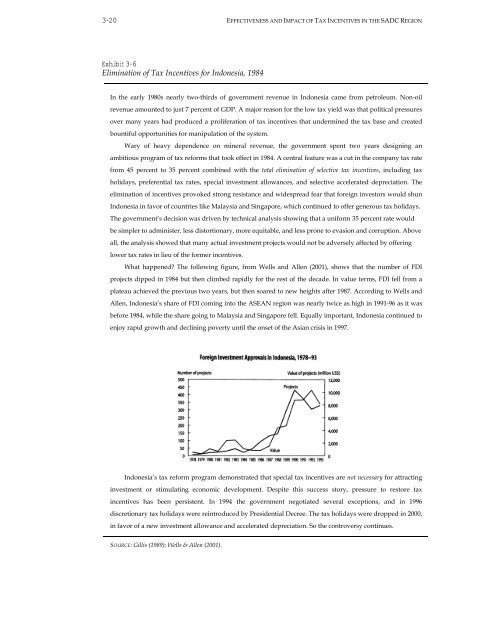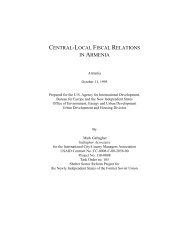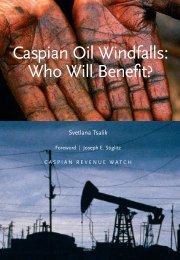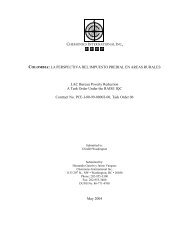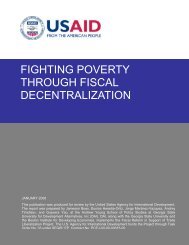Effectiveness and Economic Impact of Tax Incentives in the SADC ...
Effectiveness and Economic Impact of Tax Incentives in the SADC ...
Effectiveness and Economic Impact of Tax Incentives in the SADC ...
You also want an ePaper? Increase the reach of your titles
YUMPU automatically turns print PDFs into web optimized ePapers that Google loves.
3-20 EFFECTIVENESS AND IMPACT OF TAX INCENTIVES IN THE <strong>SADC</strong> REGION<br />
Exhibit 3-6<br />
Elim<strong>in</strong>ation <strong>of</strong> <strong>Tax</strong> <strong>Incentives</strong> for Indonesia, 1984<br />
In <strong>the</strong> early 1980s nearly two-thirds <strong>of</strong> government revenue <strong>in</strong> Indonesia came from petroleum. Non-oil<br />
revenue amounted to just 7 percent <strong>of</strong> GDP. A major reason for <strong>the</strong> low tax yield was that political pressures<br />
over many years had produced a proliferation <strong>of</strong> tax <strong>in</strong>centives that underm<strong>in</strong>ed <strong>the</strong> tax base <strong>and</strong> created<br />
bountiful opportunities for manipulation <strong>of</strong> <strong>the</strong> system.<br />
Wary <strong>of</strong> heavy dependence on m<strong>in</strong>eral revenue, <strong>the</strong> government spent two years design<strong>in</strong>g an<br />
ambitious program <strong>of</strong> tax reforms that took effect <strong>in</strong> 1984. A central feature was a cut <strong>in</strong> <strong>the</strong> company tax rate<br />
from 45 percent to 35 percent comb<strong>in</strong>ed with <strong>the</strong> total elim<strong>in</strong>ation <strong>of</strong> selective tax <strong>in</strong>centives, <strong>in</strong>clud<strong>in</strong>g tax<br />
holidays, preferential tax rates, special <strong>in</strong>vestment allowances, <strong>and</strong> selective accelerated depreciation. The<br />
elim<strong>in</strong>ation <strong>of</strong> <strong>in</strong>centives provoked strong resistance <strong>and</strong> widespread fear that foreign <strong>in</strong>vestors would shun<br />
Indonesia <strong>in</strong> favor <strong>of</strong> countries like Malaysia <strong>and</strong> S<strong>in</strong>gapore, which cont<strong>in</strong>ued to <strong>of</strong>fer generous tax holidays.<br />
The government’s decision was driven by technical analysis show<strong>in</strong>g that a uniform 35 percent rate would<br />
be simpler to adm<strong>in</strong>ister, less distortionary, more equitable, <strong>and</strong> less prone to evasion <strong>and</strong> corruption. Above<br />
all, <strong>the</strong> analysis showed that many actual <strong>in</strong>vestment projects would not be adversely affected by <strong>of</strong>fer<strong>in</strong>g<br />
lower tax rates <strong>in</strong> lieu <strong>of</strong> <strong>the</strong> former <strong>in</strong>centives.<br />
What happened? The follow<strong>in</strong>g figure, from Wells <strong>and</strong> Allen (2001), shows that <strong>the</strong> number <strong>of</strong> FDI<br />
projects dipped <strong>in</strong> 1984 but <strong>the</strong>n climbed rapidly for <strong>the</strong> rest <strong>of</strong> <strong>the</strong> decade. In value terms, FDI fell from a<br />
plateau achieved <strong>the</strong> previous two years, but <strong>the</strong>n soared to new heights after 1987. Accord<strong>in</strong>g to Wells <strong>and</strong><br />
Allen, Indonesia’s share <strong>of</strong> FDI com<strong>in</strong>g <strong>in</strong>to <strong>the</strong> ASEAN region was nearly twice as high <strong>in</strong> 1991-96 as it was<br />
before 1984, while <strong>the</strong> share go<strong>in</strong>g to Malaysia <strong>and</strong> S<strong>in</strong>gapore fell. Equally important, Indonesia cont<strong>in</strong>ued to<br />
enjoy rapid growth <strong>and</strong> decl<strong>in</strong><strong>in</strong>g poverty until <strong>the</strong> onset <strong>of</strong> <strong>the</strong> Asian crisis <strong>in</strong> 1997.<br />
Indonesia’s tax reform program demonstrated that special tax <strong>in</strong>centives are not necessary for attract<strong>in</strong>g<br />
<strong>in</strong>vestment or stimulat<strong>in</strong>g economic development. Despite this success story, pressure to restore tax<br />
<strong>in</strong>centives has been persistent. In 1994 <strong>the</strong> government negotiated several exceptions, <strong>and</strong> <strong>in</strong> 1996<br />
discretionary tax holidays were re<strong>in</strong>troduced by Presidential Decree. The tax holidays were dropped <strong>in</strong> 2000,<br />
<strong>in</strong> favor <strong>of</strong> a new <strong>in</strong>vestment allowance <strong>and</strong> accelerated depreciation. So <strong>the</strong> controversy cont<strong>in</strong>ues.<br />
SOURCE: Gillis (1989); Wells & Allen (2001).


